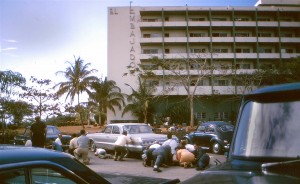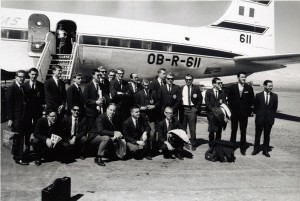Magazine

Jazz, Guns, and Governments
A U.S.-led effort in 1965 to win over Communist hearts and minds through music landed U-M Jazz Band members in the middle of gunfire in the Dominican Republic. This strange tale of U-M students, concerts, and Red Scare politics is showcased in a new collection at the Bentley, 50 years in the making.
By Dan Shine
Although it probably didn’t occur to Lanny Austin (U-M ’66, ’67 M.A.) as the bullets started to fly on that Dominican Republic hotel lawn back in April 1965, he had to be thankful that he played baritone saxophone and not, say, the flute.
Austin was part of a University of Michigan Jazz Band goodwill tour to Central and South America and the Caribbean when a rebellion broke out in the Dominican Republic’s capital city of Santo Domingo while the band was there. While waiting for the U.S. military to come get them, rebels ran through the crowd firing at a man running away.
“It was automatic gunfire. People were screaming,” Austin, now 71, says.
“I hid behind my saxophone case. It was very scary.”
No one in the group was hurt in the shooting, and the Marines soon rescued the musicians, putting them on a ship to Puerto Rico, where they eventually caught a flight to Jamaica to complete the last stops on the three-month, 15-country tour.
“The guys cheered when the [airplane] wheels finally hit the ground in Miami,” says Austin, a retired school music teacher and bandleader of the Detroit-area Austin-Moro Big Band.
The Detroit media—and anxious parents—were waiting for them when they landed at Willow Run Airport.
Despite the chaos in the Dominican Republic, the budget accommodations, and bouts of severe gastroenteritis that sometimes left the band shorthanded for performances, the 18-member ensemble wanted to commemorate the tour and their memories therein.

After being told to gather on the lawn of their Dominican Republic hotel to await rescue by U.S. troops, shooting erupted and several band members hid behind cars in the hotel parking lot.
Late in 2015, the trip’s 50th anniversary year, Austin and others in the ensemble began donating items to the Bentley. These items included photos, newspaper clippings, performance posters in Spanish, itineraries, pamphlets on each country, and brochures given to the band from the U.S. Department of State with titles such as “Democracy vs. Dict-ators” and “U.S. Policy toward Cuba.”
Austin says many in the Jazz Band also played in the U-M Symphony Band and knew members who had toured the Soviet Union in 1961 in a similar goodwill mission. Austin attended a reunion of the Symphony Band a few years ago to further coalesce former U-M musicians who had toured abroad in hopes of promoting future trips for students.
“While at the reunion, I met some Bentley Library folks who had started preserving the ’61 tour, and at their suggestion I pursued the idea of also preserving our ’65 jazz tour,” he says.
Uncle Sam Wants You
That the band was even asked to participate in the ’65 jazz tour was a surprise. The U-M Jazz Band was student-led, wasn’t given a suitable rehearsal spot on campus, and while officially recognized by the School of Music, it got little support from the school or the famed University director of bands, William Revelli, who was not a jazz fan.
But the band performed well at a jazz festival at the University of Notre Dame—the band paid its own way—which was attended by three U.S. State Department officials looking for a jazz group for its Cultural Presentations Program. The government considered cultural tours like the one done by the Jazz Band to be a good way to win the hearts and minds of people in countries where Communism might be a consideration.
To calm concerned parents, government officials told them “Uncle Sam has his finger on the pulse of Latin American politics,” Austin recalls. He and roommate and friend Joe Mallare (U-M ’66, ’67 M.A.) saw it simply as a chance to travel the globe and play music.
“Lanny’s dad was a writer. My dad was a factory worker,” says Mallare, 71, a retired school band director who also donated tour items to the Bentley to ensure the trip is never forgotten. “Everyone we talked to thought it was a once-in-a-lifetime trip.”
And the potential threats? “I was 20. I was invincible,” Mallare says with a laugh.
The band flew to Guatemala in January 1965 for its first stop. U.S. embassies in each country arranged the concerts, which ranged from free shows in village squares, local schools, and universities, to performances with paid admission at local theaters.
Audiences varied—from the very poor who didn’t know a thing about jazz and covered their ears—to aficionados who invited band members back to their home to see their extensive jazz record collections. There were moments of anti-American catcalls at shows, but nothing threatening, Austin and Mallare say.
As they entered each country, the band members received a packet about what to do and not do, what to eat and drink, and what to avoid. One piece of advice: keep your mouth closed while showering. Band members often brushed their teeth with Coca-Cola or beer.
Bossa Nova and Bullets
The tour was headed toward Haiti when it was decided that dictator Francois “Papa Doc” Duvalier—who studied public health at U-M—might exploit the band’s appearance for political gain. A detour to the supposedly safer Dominican Republic was hastily arranged. The band played a couple of concerts in and around Santo Domingo, and began to notice naval ships anchoring off the coast and military vehicles patrolling the streets.
In the middle of one night, the band was told to grab what they could because they were moving to a hotel a mile down the road. From the roof of their new hotel, the band watched as their old hotel was strafed and bombed by military jets. The Dominican Civil War, which would last until September 1965 and eventually involve the U.S. occupation of the Dominican Republic, had begun.

The University of Michigan Jazz Band on a leg of their goodwill tour to Central and South America in 1965.
Quickly, the hotel workers left, the candy machine was emptied, and the musicians went two days without food. Then came whispered words to assemble on the hotel front lawn at 4:30 a.m. Austin packed one suitcase and stuffed souvenirs down the bell of his sax.
The sun came up on a quiet morning—no skirmishes between rebels and the military—so a couple of band members pulled out guitars and an alto sax to play bossa nova—a relatively new style of Brazilian music at that time—for the hundred or so Americans on the lawn.
“All of a sudden bullets started to fly,” Mallare says. “Everyone dropped to the ground. We found out later they weren’t shooting at us. It was not that close, but close enough to duck behind cars.”
Or saxophone cases. “I was the trip photographer, but I was ducking for cover,” Austin says.
The stories of the tour— and especially from the Domi-nican Republic—have given the group great cocktail party conversation fodder over the years. Mallare and Austin, who live about seven miles from each other and play tennis frequently, often retold tales from the tour.
“Lanny and I always talked about it,” Mallare says. “It was not the most glamorous tour someone could take, but what memories. But I will say our wives are tired of listening to us talk about it.”
